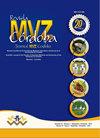犬乳腺肿瘤:危险因素及其在哥伦比亚马尼萨莱斯的流行病学影响
IF 0.3
4区 农林科学
Q4 AGRICULTURE, DAIRY & ANIMAL SCIENCE
引用次数: 0
摘要
目标。描述2014-2017年哥伦比亚马尼萨莱斯市女性犬乳腺肿瘤(CMT)的患病率。材料和方法。合并了15961例患者的数据库。分析的变量包括肿瘤品种、年龄、生殖史、体重、饮食类型和临床特征,肿瘤-淋巴结-转移分期系统。统计学分析采用连续性的Pearson卡方检验和Fisher精确检验(p<0.05),相对风险和优势比(CI95%),生存分析采用Kaplan-Meier估计。结果。纯种犬发病率为79.14%,平均年龄9.3岁为高峰。Pearson卡方检验、相对危险度和比值比均显示纯种犬患病风险较高(p分别为0.019、3.96/100、1.64)。年龄在9到12岁之间的女性患乳腺肿瘤的可能性为74%。没有发现体重或生育阶段有显著关系,但与自制饮食有高度关联(p<0.001)。腹股沟乳对受影响最大(6.9%)。Kaplan-Meier估计显示,手术干预患者的生存率更高,手术诊断后的生存时间为2013天,而未手术的生存时间为1484天。结论。该研究证实了危险因素、品种类型、年龄、身体状况和饮食类型与乳腺肿瘤表现的相关性。此外,考虑到兽医诊断信息系统在公共卫生中的重要性,它强调了改进和整合兽医诊断信息系统的必要性。本文章由计算机程序翻译,如有差异,请以英文原文为准。
Canine mammary gland tumors: risk factors and their epidemiological influence in Manizales-Colombia
Objective. To describe the prevalence of canine mammary gland tumors (CMT) in females in the municipality of Manizales-Colombia from 2014-2017. Materials and methods. A database of 15961 patients was consolidated. The variables analyzed were, breed, age, reproductive history, weight, diet type and clinical characterization of the tumor with the TNM (tumor-node-metastases) staging system. The statistical analysis include Pearson’s chi-squared test with Yates correction for continuity and Fisher’s exact test (p<0.05), relative risk and odds ratio (CI95%) and Kaplan-Meier estimator for survival analysis. Results. The incidence in purebred dogs was 79.14%, with a peak at the average age of 9.3 years old. Pearson’s chi-squared test and the relative risk and odds ratios indicated a high risk for purebreds (p=0.019, 3.96/100, 1.64, respectively). Females of ages between 9 and 12 years old showed a 74% likelihood of developing a mammary tumor. No found significant relation to weight or reproductive stage but indeed a high association with homemade diet (p<0.001). The inguinal mammary pairs were the most affected (6.9%). The Kaplan-Meier estimate showed a higher survival of surgically-intervened patients, with 2013 days of survival after diagnosis with surgery compared to 1484 days without surgery. Conclusions. The study confirmed the relevance of risk factors, breed type, age, body condition and diet type in the mammary tumor presentation. Furthermore, it highlights the need for improving and integrating the veterinary diagnostic information systems, considering their importance in public health.
求助全文
通过发布文献求助,成功后即可免费获取论文全文。
去求助
来源期刊

Revista Mvz Cordoba
农林科学-奶制品与动物科学
CiteScore
0.70
自引率
0.00%
发文量
41
审稿时长
6-12 weeks
期刊介绍:
The Journal MVZ Córdoba is an open access international scientific journal financed and edited by the University of Córdoba (Colombia). The journal publishes quarterly, continuously in PDF, XML, Epub, original articles, literature reviews, brief communications and clinical cases, peer-reviewed (double-blind) in Spanish and English, which are related to the agricultural and veterinary sciences. The journal is directed to natural and legal persons of veterinary medicine, animal husbandry, public health, epidemiology, aquaculture, biology, basic biomedical sciences and biotechnology and constitutes a space for academic and scientific discussion around the work of professionals in Veterinary Medicine and Zootechnics. Four-monthly publication.
"The Journal MVZ Córdoba supports the policies for registration of clinical trials of the World Health Organization (WHO) and the International Committee of Medical Journal Editors (ICMJE), since it recognizes the importance of these initiatives for international registration and dissemination. of information about clinical studies, in open access. As a result, since 2007, the journal MVZ Córdoba only publishes clinical research articles that have received an identification number in one of the Clinical Trial Registries validated by the criteria established by WHO and ICMJE, whose addresses are available in the ICMJE website. The identification number is recorded at the end of the summary. "
 求助内容:
求助内容: 应助结果提醒方式:
应助结果提醒方式:


